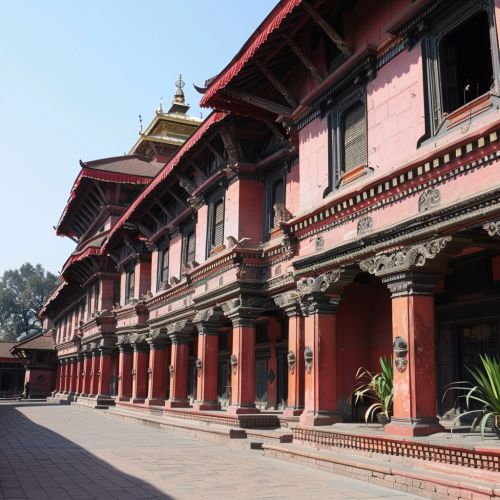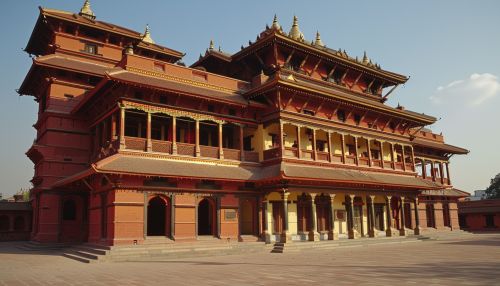Shah dynasty
History of the Shah Dynasty
The Shah dynasty, also known as the Shahs of Nepal, was the ruling dynasty of the Kingdom of Nepal from 1768 to 2008. This dynasty was founded by Prithvi Narayan Shah, who unified the small principalities of the Kathmandu Valley and surrounding regions into a single nation-state. The Shah dynasty's rule ended with the establishment of a federal democratic republic in 2008.
Founding and Early Expansion
Prithvi Narayan Shah, the first king of unified Nepal, ascended to the throne of the small principality of Gorkha in 1743. He embarked on a campaign to unify the numerous small kingdoms and principalities in the region, which culminated in the conquest of the Kathmandu Valley in 1768. This marked the beginning of the Shah dynasty's rule over Nepal.
Prithvi Narayan Shah's military campaigns were characterized by strategic alliances, diplomatic maneuvers, and the use of modern weaponry. His vision of a unified Nepal was driven by the need to resist the growing influence of the British East India Company in the Indian subcontinent.
Consolidation and Governance
Following the unification, the Shah dynasty focused on consolidating its power and establishing a centralized administration. The capital was moved to Kathmandu, and efforts were made to integrate the diverse ethnic and cultural groups within the newly formed kingdom. The Shah rulers adopted a policy of religious tolerance, promoting Hinduism while respecting the traditions of other religious communities.
The administrative structure of the Shah dynasty was hierarchical, with the king at the apex, followed by regional governors and local chieftains. The legal system was based on traditional Hindu law, with modifications to accommodate local customs and practices.


Relations with Neighboring States
The Shah dynasty maintained complex relationships with neighboring states, including Tibet, China, and British India. Diplomatic missions were sent to the Qing dynasty in China to secure recognition and support. The Treaty of Sugauli, signed with the British East India Company in 1816, marked a significant turning point, as it resulted in the cession of large territories and established the boundaries of modern Nepal.
The Shah rulers navigated the delicate balance of maintaining independence while engaging in trade and diplomatic relations with powerful neighbors. This period saw the rise of the Rana dynasty, which effectively controlled the government while the Shah kings remained figureheads.
The Rana Era
From 1846 to 1951, the Shah dynasty's power was overshadowed by the Rana dynasty, which established a hereditary prime ministership and ruled with an iron fist. The Ranas implemented significant reforms, including the modernization of the military and infrastructure, but their autocratic rule led to widespread discontent.
The Shah kings during this period were largely ceremonial, with limited political influence. The Rana regime's isolationist policies and resistance to change eventually led to its downfall, as a popular movement for democracy gained momentum.
Restoration of Shah Rule
In 1951, King Tribhuvan, with the support of pro-democracy forces and Indian assistance, successfully overthrew the Rana regime. This marked the restoration of the Shah dynasty's political power and the beginning of a constitutional monarchy. A series of democratic reforms were introduced, including the establishment of a parliamentary system and the drafting of a new constitution.
King Mahendra, who succeeded Tribhuvan, initially supported democratic governance but later dissolved the parliament and introduced the Panchayat system, a party-less political system that centralized power in the monarchy. This period saw significant economic and social development, but also political repression and curtailment of civil liberties.
The People's Movement and the End of Monarchy
The late 20th century was marked by growing demands for democratic reforms and an end to autocratic rule. The People's Movement of 1990 led to the restoration of multi-party democracy and the promulgation of a new constitution, which limited the powers of the king and established Nepal as a constitutional monarchy.
However, political instability and a decade-long Maoist insurgency culminated in the Nepalese Civil War, which significantly weakened the monarchy. In 2001, the Nepalese royal massacre resulted in the death of King Birendra and most of the royal family, leading to the ascension of King Gyanendra.
King Gyanendra's attempts to reassert absolute power were met with widespread opposition, leading to the Second People's Movement in 2006. This movement forced the king to relinquish power and paved the way for the abolition of the monarchy. In 2008, Nepal was declared a federal democratic republic, officially ending the Shah dynasty's 240-year rule.
Cultural and Social Contributions
The Shah dynasty played a significant role in shaping the cultural and social landscape of Nepal. The promotion of Nepali language as the lingua franca helped unify the diverse ethnic groups within the kingdom. The Shah rulers also patronized arts, literature, and architecture, leading to the flourishing of Newar culture in the Kathmandu Valley.
The construction of temples, palaces, and other architectural marvels during the Shah era left a lasting legacy. The Hanuman Dhoka Palace, Pashupatinath Temple, and Swayambhunath Stupa are some of the notable landmarks from this period.
Economic Policies and Development
The economic policies of the Shah dynasty were aimed at promoting self-sufficiency and reducing dependence on foreign powers. Agriculture was the mainstay of the economy, with efforts to improve irrigation, land reforms, and the introduction of new crops. Trade with Tibet, India, and China was encouraged, and the establishment of trade routes facilitated economic growth.
The Shah rulers also focused on infrastructure development, including the construction of roads, bridges, and public buildings. The introduction of modern education and healthcare systems laid the foundation for future development.
Legacy and Impact
The legacy of the Shah dynasty is complex and multifaceted. On one hand, the unification of Nepal and the establishment of a centralized state provided a sense of national identity and cohesion. On the other hand, the autocratic rule and political repression during certain periods left a legacy of social and political challenges.
The transition to a federal democratic republic marked a new chapter in Nepal's history, but the influence of the Shah dynasty remains evident in the country's cultural, social, and political fabric. The contributions of the Shah rulers to the development of Nepal continue to be recognized and debated by historians and scholars.
